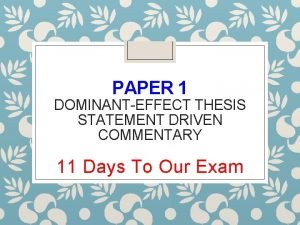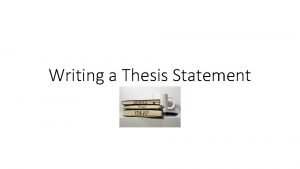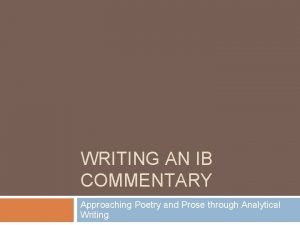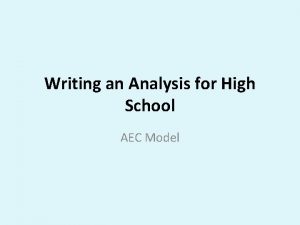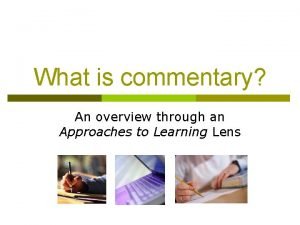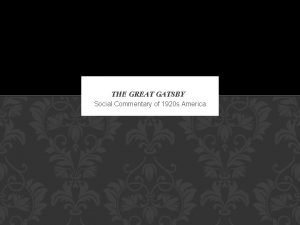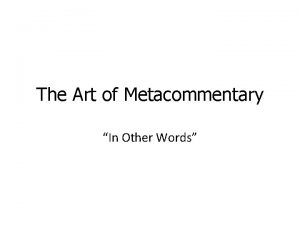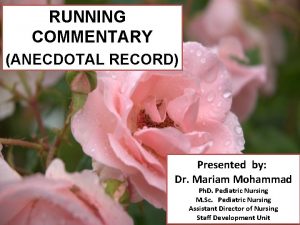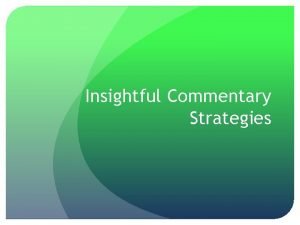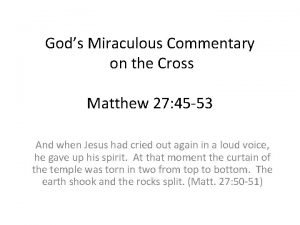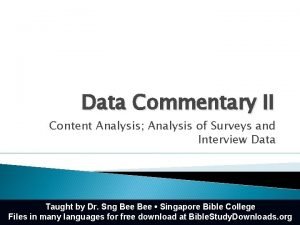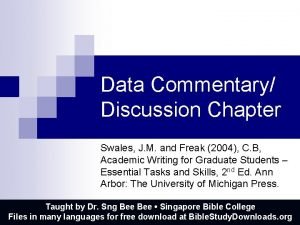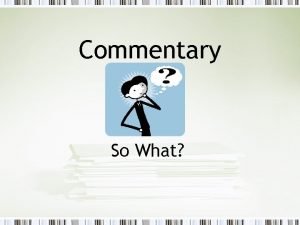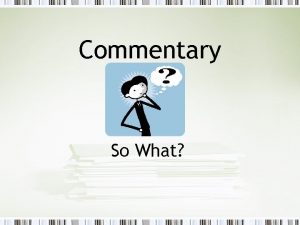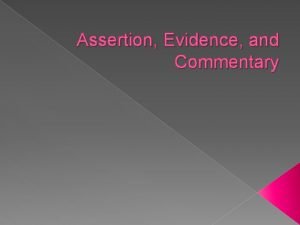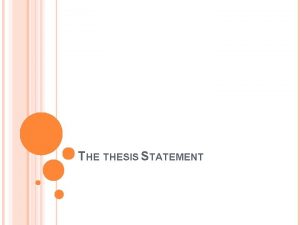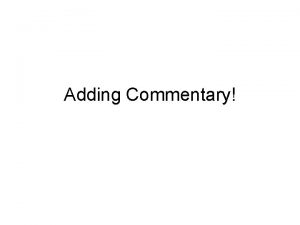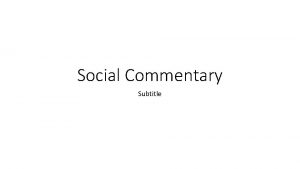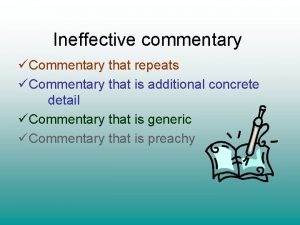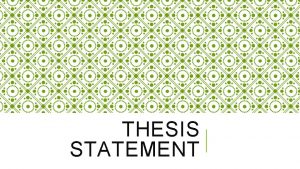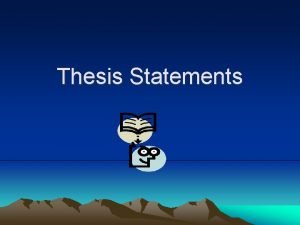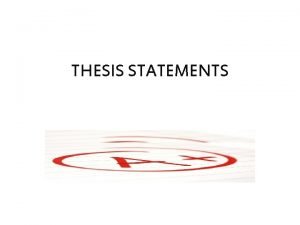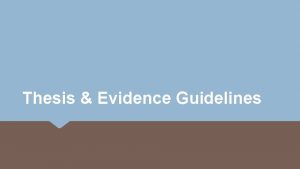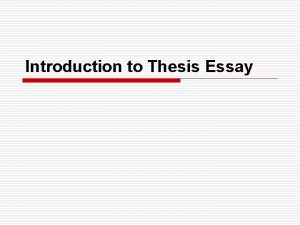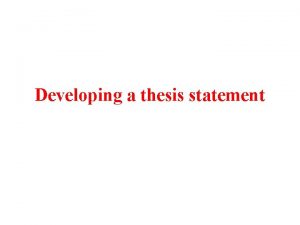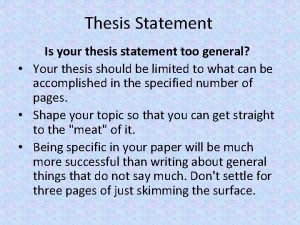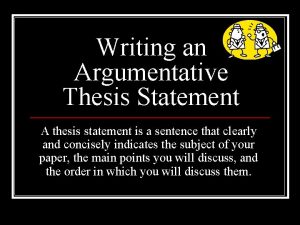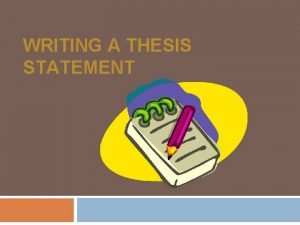PAPER 1 DOMINANTEFFECT THESIS STATEMENT DRIVEN COMMENTARY 11

















- Slides: 17

PAPER 1 DOMINANT-EFFECT THESIS STATEMENT DRIVEN COMMENTARY 11 Days To Our Exam

WHAT’S A COMMENTARY AGAIN? ◦ Commentary=close reading and interpretation of a passage presented in essay form ◦ You will demonstrate ◦ Understanding of thought (ideas) and feeling (emotions) of the passage ◦ Support your points with detailed references to the passage (quotations) ◦ Analyze and show appreciation of how the passage achieves its effects

For Paper I, how much should I write? ◦ Flipping through finished practice exams, we can almost always predict scores based on length. ◦ When we had kids write on notebook paper, double-spaced, I would tell them 6 -8 pp = fully developed (this is when they have 2 hours); 4 pages or less = underdeveloped = will score lower

Writing an Introduction to your commentary… ◦Go straight to the literature ◦ Write 2 -3 sentences explaining what the poem or passage is about (shows understanding) ◦ Write your thesis stating a clear argument about dominant effect (intellectual and emotional). Do NOT list a bunch of techniques.

Commentary Body Paragraphs ◦Nuanced evidence analyzed insightfully ◦Well-paragraphed ◦New idea, new paragraph ◦BTSs show the clear development of your argument, linking one idea to the next

Conclusion of your commentary ◦Don’t repeat ◦Briefly sum up what you’ve said ◦DRAW A CONCLUSION – so what?

Using Titles of Prose and Poetry Selections ◦ Short story titles are related in quotes ◦ In Karen Russell’s “Swamplandia!”, she uses [some dominant literary device] to [show something significant about the world]. ◦ Poem titles are related in quotes ◦ **The Art of the Lathe is the book that the poem is published in, and you won’t need that title for your essay at all. ◦ In B H Fairchild’s poem, “The Machinist, Teaching his Daughter to Play the Piano”, the author uses [some dominant literary device] to [show something significant about the world].


B H Fairchild’s “The Machinist, Teaching his Daughter to Play the Piano” ◦ Dominant Motifs: ◦ Parenting/teaching/molding ◦ Communication ◦ Machinery [or roughness] vs Art [or delicacy] ◦ Religious imagery ◦ Music ◦ Hand Imagery ◦ Structure: ◦ Use of tercets and physical structure ◦ Italics vs plain font ◦ Varied Interpretations: ◦ Is the daughter speaking or is that piano noise?

GET YOUR WRITING FOLDER ◦MAKE ABSOLUTELY SURE YOU HAVE YOUR WRITING FOLDER IN CLASS TOMORROW AS WE WILL BE CHARTING YOUR PROGRESS

IN YOUR WRITING FOLDER, you should have… ◦ Paper 1: Sonnet one-pager rubric ◦ Paper 2: Hamlet rubric with reflection on the back ◦ Paper 1: Semester I Final Exam ◦ 4 th: “Specimen Paper” ◦ 6 th: 2007 Exam ◦ Paper 2: Woolf/Austen comparative essay ◦ Paper 1: 2016 Exam Intro & Outline

Karen Russell’s “Swamplandia!”, ◦ Dominant Motifs: ◦ Predatory tourism ◦ Gender roles/sexism/marriage discord ◦ Appearance v reality ◦ Narrative voice: youthful ◦ Maternal sacrifice ◦ Color green

Structuring your Paper 1 Essay: Linear/Chronological ◦ Moves sequentially ◦ PROS: ◦ Can work well when an extract has a clear sense of development ◦ Topic statements (first sentences of paragraphs) can focus on points of transition ◦ CONS: ◦ Danger of falling into retelling

Structuring your Paper 1 Essay: Conceptual/Thematic ◦ Organized by different aspects of content and language (Key Aspects/Ideas/Techniques) ◦ EXAMPLE: ◦ Par. 1: Character of Narrator ◦ Par. 2: Her Relationship with her parents ◦ Par. 3: Setting ◦ Par. 4: Controlling Metaphor ◦ Par. 5: Etc. . Look at language/techniques as you go to support points

Structuring your Paper 1 Essay: Conceptual ◦ PROS: ◦ More holistic ◦ Allows you to show more control over your thesis, and develop your ideas more coherently

Structuring your Paper 1 Essay: Remember… ◦ No formula guarantees success ◦ Careful thinking for yourself about the best way to structure your commentary is key

Plan for a Paper 1 Commentary ◦ What kind of “reading” have you come up with? ◦ Does it highlight a particular aspect of content or style? ◦ Does it ask from where the poem gains its main strength? ◦ Does it focus on a contrast or conflict, or a significant development? ◦ What kinds of structure might you follow? ◦ One that traces the linear development of the poem, or perhaps one that breaks the poem’s features down into concepts? ◦ Once you’ve decided, create your outline
 Paper 1 thesis statement
Paper 1 thesis statement Open thesis statements
Open thesis statements Aice english paper 2
Aice english paper 2 Aice general paper
Aice general paper A concept paper
A concept paper Poem commentary example
Poem commentary example Aec writing format
Aec writing format What is commentary?
What is commentary? Great gatsby social commentary
Great gatsby social commentary Meta commentary meaning
Meta commentary meaning Anecdotal records in nursing examples
Anecdotal records in nursing examples Commentary summary
Commentary summary Matthew 27:50 meaning
Matthew 27:50 meaning Data commentary sample
Data commentary sample What is data commentary
What is data commentary Cd sentence starters
Cd sentence starters Concrete and specific details
Concrete and specific details It is your evidence and assertion together
It is your evidence and assertion together
